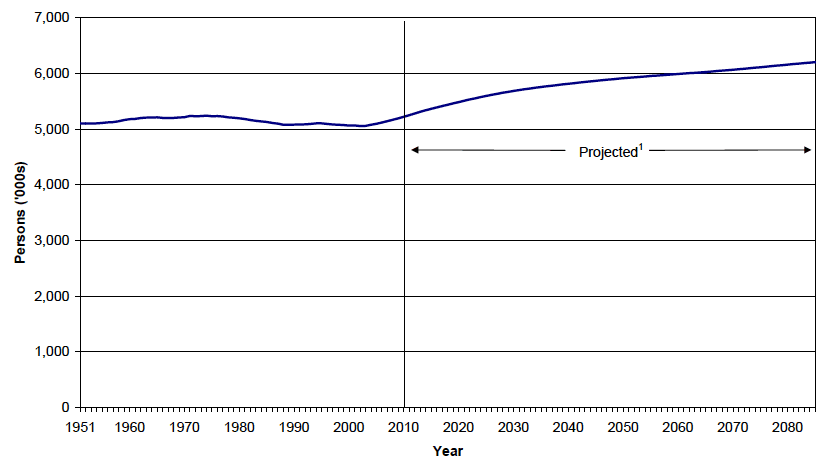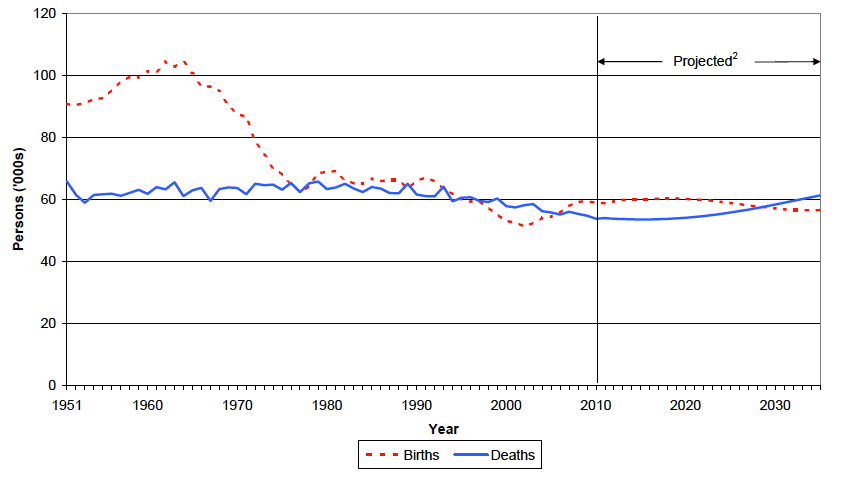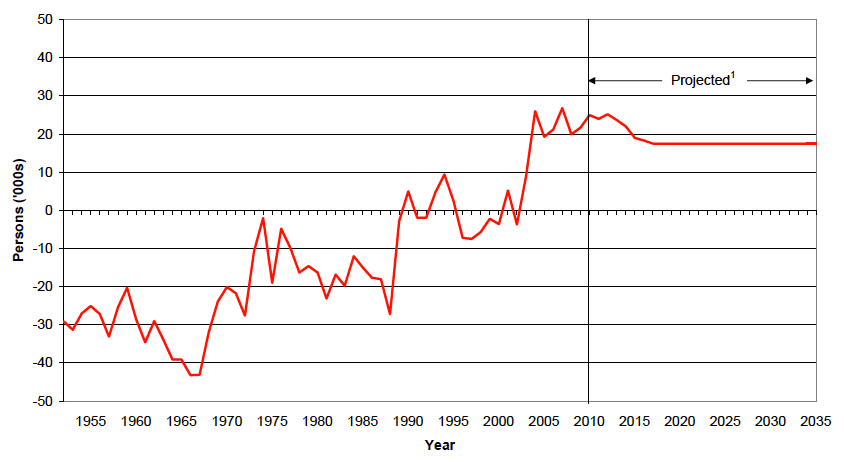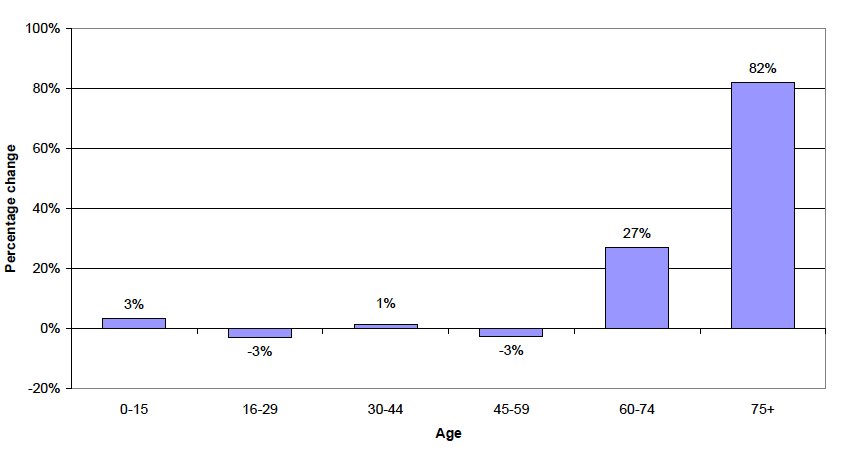
3.1. The results of this new set of projections, summarised in Table 1 and illustrated in Figure 1, show the total population of Scotland increasing from 5.22 million in 2010 and rising above Scotland's record 1974 population of 5.24 million in the first year of the projections. After this, the population is projected to reach 5.49 million in 2020 (an increase of about 264,000 or 5 per cent compared with 2010) and then 5.76 million by 2035 (a 10 per cent increase on the 2010 level). Looking further ahead, the population is projected to continue to rise, reaching around 6.20 million by 2085.
Figure 1 Estimated population of Scotland, actual and projected, 1951-2085

3.2. Table 2 provides information on the projected components of change between 2010 and 2035. The table shows that up until around 2028 natural change and migration both act to increase the size of the population as the number of births exceeds the number of deaths and there are more people coming to Scotland than leaving. After that point, the number of deaths exceeds the number of births whilst net in-migration continues.
3.3. As Figure 2 shows, the number of births in Scotland fell significantly between the early 1960s and 2002, dropping below the number of deaths in 1995. Between 2002 and 2009, the number of births increased steadily but then it dipped slightly (by around 400 births) in 2010. The increase in births resulted in positive natural change - more births than deaths - from 2006 onwards, and although the number of births decreased slightly in 2010 the number of deaths also fell resulting in positive natural change for this year too. The projections suggest a slight increase in the number of births until a peak in 2018 of around 60,300. Thereafter births generally decline but only to about 56,500, remaining well above the historically low number of births observed in 2002. Meanwhile, the number of deaths is projected to fall until 2015 reaching a low of around 53,500, before increasing back to the levels experienced in the 1990s by 2035.
Figure 2 Births and deaths, actual1 and projected2, Scotland, 1951-2035

3.4. As Figure 3 shows, Scotland has historically been a country of net out-migration with more people leaving the country than coming. However, since 2002 Scotland has experienced net in-migration, and therefore these projections have assumed that Scotland will continue to experience a net inflow. The size of this net inflow is assumed to rise to 25,200 in 2011-12 before falling steadily to 17,500 by 2016-17, and staying at this level for the remainder of the projection period.
Figure 3 Estimated and projected net migration, Scotland, 1951-2035

3.5. More detailed information on the fertility, mortality and migration assumptions leading to these results is given in Section 4 and Annex A, Annex B and Annex C.
3.6. A summary of projected populations in broad age groups is given in Table 3, and projected populations by sex and five year age groups are given in Table 6. These tables and Figure 4 show that the age structure of the population is projected to age noticeably between 2010 and 2035.
Figure 4 The projected percentage change in Scotland's population by age group, 2010-2035

3.7. Scotland's population is projected to increase by 10 per cent between 2010 and 2035, however this increase is not spread evenly across all age groups of the population. As Figure 4 shows, the population aged under 60 is projected to remain fairly constant whilst the number of older people is projected to increase significantly.
3.8. Between 2010 and 2020, the number of children (aged 0-15) is projected to increase by 5 per cent from 0.91 to 0.96 million. It is then projected to peak at 0.97 million in 2023 before decreasing steadily to 0.94 million by 2035 (a 3 per cent increase compared with 2010).
3.9. The figures for working age and pensionable age take into account the increases in the state pension age which will rise from 60 to 65 for women between 2010 and 2020, and then from 65 to 66 for both men and women between 2024 and 2026. A further increase to age 68 for both men and women will occur between 2034 and 2046.
3.10. With the changes to state pension age included, the population of working age is projected to increase from 3.27 million in 2010 to 3.45 million in 2020 (an increase of 6 per cent). It is then projected to increase slightly to a peak of 3.50 million in 2026, before falling slightly to 3.46 million in 2033 and then rising to 3.50 million in 2035 (an increase of 7 per cent compared with 2010).
3.11. The number of people of pensionable age is projected to rise from 1.04 million in 2010 to 1.07 million in 2020 (an increase of 3 per cent). It is then projected to rise more rapidly, reaching 1.32 million in 2035 (an increase of around 26 per cent compared with 2010). There are a few dips in the projected population for this age group over the period but these can be explained by the changes in state pension age.
3.12. Were it not for these changes to state pension age, the population of working age would be projected to decrease by around 2 per cent and the population of pensionable age to increase by 53 per cent by 2035.
3.13. The number of people aged 75 and over is projected to increase by around 23 per cent from 0.41 million in 2010 to 0.50 million in 2020. It is then projected to continue rising, reaching 0.74 million in 2035 - an increase of 82 per cent over the 25 year period. This is due to the ageing of the baby boomers born after the Second World War who will be in their mid eighties by 2035, and also because mortality rates are projected to improve, increasing the population at older ages.
3.14. A useful summary measure of the age structure of a population is the dependency ratio - the ratio of people aged under 16 and those over pensionable age, to those of working age. Table 4 shows that the dependency ratio is projected to remain more or less stable at around 59 per 100 until 2020. Between 2020 and 2024 the dependency ratio is projected to increase to 62 per 100 working age population. It then dips back down to 60 in 2026 before rising steadily to 66 in 2034. It dips again in 2035 to 64. The relatively slow initial increase in the dependency ratio and the dips throughout the projection period are mainly due to the changes to the state pension age (Section 3.9). In the absence of these changes, the dependency ratio would be projected to rise to 79 per 100 by 2035.
3.15. In 2010, the 60 dependents per 100 working age population were made up relatively evenly of children (28 per 100) and pensioners (32 per 100). By 2035 the distribution is projected to have changed to 27 children and 38 pensioners per 100 population of working age.